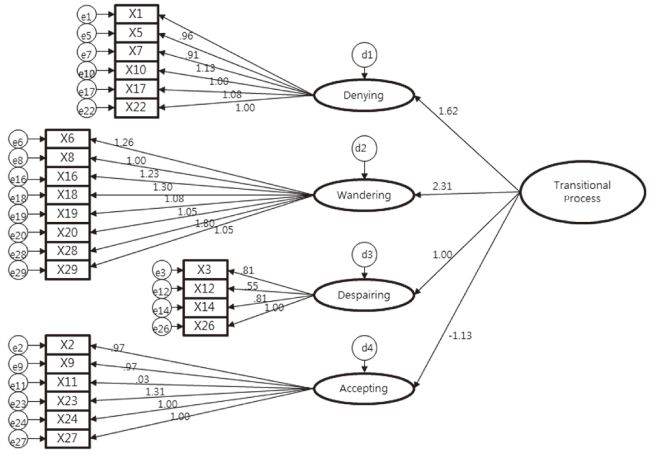J Korean Acad Nurs.
2014 Oct;44(5):563-572. 10.4040/jkan.2014.44.5.563.
Construct Validity of the Life Transition Scale for Parents of Children with Autism
- Affiliations
-
- 1Department of Nursing, Wonkwang Health Science University, Iksan, Korea.
- 2Department of Emergency Medical Technology, Daejeon University, Daejeon, Korea. swhong@dju.kr
- 3Department of Nursing, Namseoul University, Cheonan, Korea.
- KMID: 2129546
- DOI: http://doi.org/10.4040/jkan.2014.44.5.563
Abstract
- PURPOSE
The study was done to identify the construct validity and reliability of the life transition scale (LTS) for parents who have children with autism.
METHODS
Exploratory factor analysis (EFA) and confirmative factor analysis (CFA) were conducted to identify the most adequate measurement model for structural validity. Convergent validity and discriminant validity were also conducted for structural validity. Data were collected from 208 parents through self-reported questionnaires and analyzed with SPSS/WIN 15.0 and AMOS 20.0 version.
RESULTS
A four factor-structure was validated (chi2=541.23, p<.001, GFI=.82, RMSEA=.07, IFI=.89, CFI=.89, PNFI=.73, Q (chi2/df)=2.20) at the 3rd order of EFA and CFA, and factors were named as denying, wandering, despairing, and accepting. Both convergent and determinant validity for LTS were 100%. Cronbach's alphas for the reliability of each structure were .77-.90 and .83 for total structure.
CONCLUSION
The four structures, 24-item instrument showed satisfactory reliability and validity. LTS has the potential to be appropriate for assessing the transition process of life for parents who have children with autism and provides basic directions for differentiated support and care at each stage.
Keyword
MeSH Terms
Figure
Reference
-
1. Ministry of Health & Welfare. Status of disabled [Internet]. Seoul: Author;2013. cited 2014 May 1. Available from: http://www.index.go.kr/potal/main/EachDtlPageDetail.do?idx_cd=2768.2. Hall HR, Graff JC. Maladaptive behaviors of children with autism: Parent support, stress, and coping. Issues Compr Pediatr Nurs. 2012; 35(3-4):194–214. http://dx.doi.org/10.3109/01460862.2012.734210.3. Hoffman CD, Sweeney DP, Hodge D, Lopez-Wagner MC, Looney L. Parenting stress and closeness: Mothers of typically developing children and mothers of children with autism. Focus Autism Other Dev Disabl. 2009; 15(1):178–187. http://dx.doi.org/10.1177/1088357609338715.4. Dabrowska A, Pisula E. Parenting stress and coping styles in mothers and fathers of pre-school children with autism and Down syndrome. J Intellect Disabil Res. 2010; 54(3):266–280. http://dx.doi.org/10.1111/j.1365-2788.2010.01258.x.5. Hayes SA, Watson SL. The impact of parenting stress: A meta-analysis of studies comparing the experience of parenting stress in parents of children with and without autism spectrum disorder. J Autism Dev Disord. 2013; 43(3):629–642. http://dx.doi.org/10.1007/s10803-012-1604-y.6. Davis NO, Carter AS. Parenting stress in mothers and fathers of toddlers with autism spectrum disorders: Associations with child characteristics. J Autism Dev Disord. 2008; 38(7):1278–1291. http://dx.doi.org/10.1007/s10803-007-0512-z.7. Gray DE. Coping over time: The parents of children with autism. J Intellect Disabil Res. 2006; 50(Pt 12):970–976. http://dx.doi.org/10.1111/j.1365-2788.2006.00933.x.8. Lee AR, Hong SW, Kim JS, Ju SJ. Life transition of mothers of children with autism. J Korean Acad Nurs. 2010; 40(6):808–819. http://dx.doi.org/10.4040/jkan.2010.40.6.808.9. Lee AR, Hong SW, Ju SJ. Development of a scale to measure life transition process in parents of children with autism. J Korean Acad Nurs. 2012; 42(6):861–869. http://dx.doi.org/10.4040/jkan.2012.42.6.861.10. Lee K, Shin S. Validity of instrument development research in Korean nursing research. J Korean Acad Nurs. 2013; 43(6):697–703. http://dx.doi.org/10.4040/jkan.2013.43.6.697.11. Kang H. A guide on the use of factor analysis in the assessment of construct validity. J Korean Acad Nurs. 2013; 43(5):587–594. http://dx.doi.org/10.4040/jkan.2013.43.5.587.12. Bae BR. Structural equation modeling with Amos 7: Principles and practice. Seoul: CRBooks;2007.13. Kim GS. New Amos 16.0 Structural equation modeling analysis. Seoul: Hannarae Publishing Co.;2007.14. Kang H. Discussions on the suitable interpretation of model fit indices and the strategies to fit model in structural equation modeling. J Korean Data Anal Soc. 2013; 15(2):653–668.15. Lee Y, Lee M. Development and validity of workplace bullying in nursing-type inventory (WPBN-TI). J Korean Acad Nurs. 2014; 44(2):209–218. http://dx.doi.org/10.4040/jkan.2014.44.2.209.16. Yu JP. Concept and understanding of structure equation model: Amos 4.0-20.0. Seoul: Hannarae Publishing Co.;2012.17. Kim EJ. Accessing factor structure and construct validity of the successful aging inventory. J Korean Acad Nurs. 2013; 43(4):568–578. http://dx.doi.org/10.4040/jkan.2013.43.4.568.18. Boström PK, Broberg M, Hwang P. Parents' descriptions and experiences of young children recently diagnosed with intellectual disability. Child Care Health Dev. 2010; 36(1):93–100. http://dx.doi.org/10.1111/j.1365-2214.2009.01036.x.19. Penzo JA, Harvey P. Understanding parental grief as a response to mental illness: Implications for practice. J Fam Soc Work. 2008; 11(3):323–338. http://dx.doi.org/10.1080/10522150802292616.20. Churchill SS, Villareale NL, Monaghan TA, Sharp VL, Kieckhefer GM. Parents of children with special health care needs who have better coping skills have fewer depressive symptoms. Matern Child Health J. 2010; 14(1):47–57. http://dx.doi.org/10.1007/s10995-008-0435-0.21. Neely-Barnes SL, Hall HR, Roberts RJ, Graff JC. Parenting a child with an autism spectrum disorder: Public perceptions and parental conceptualizations. J Fam Soc Work. 2011; 14(3):208–225. http://dx.doi.org/10.1080/10522158.2011.571539.22. Green SE. "We're tired, not sad": Benefits and burdens of mothering a child with a disability. Soc Sci Med. 2007; 64(1):150–163. http://dx.doi.org/10.1016/j.socscimed.2006.08.025.23. Hastings RP, Kovshoff H, Brown T, Ward NJ, Espinosa FD, Remington B. Coping strategies in mothers and fathers of preschool and school-age children with autism. Autism. 2005; 9(4):377–391. http://dx.doi.org/10.1177/1362361305056078.24. Lee AR. A structural model of caring behavior of mothers of disabled children. J Korean Acad Nurs. 2009; 39(5):673–682. http://dx.doi.org/10.4040/jkan.2009.39.5.673.25. Wang P, Michaels CA, Day MS. Stresses and coping strategies of Chinese families with children with autism and other developmental disabilities. J Autism Dev Disord. 2011; 41(6):783–795. http://dx.doi.org/10.1007/s10803-010-1099-3.26. Hines M, Balandin S, Togher L. Buried by autism: Older parents' perceptions of autism. Autism. 2012; 16(1):15–26. http://dx.doi.org/10.1177/1362361311416678.
- Full Text Links
- Actions
-
Cited
- CITED
-
- Close
- Share
- Similar articles
-
- Development of a Scale to Measure Life Transition Process in Parents of Children with Autism
- Validity and Reliability of the Life Transition Scale in Parents of Disabled Children Across the Life Transition Process
- Differences in Life Transition Process of Parents Caring for Children with Autism: Based on the Socio-Demographic Characteristics
- Life Transition Process Effects on Depressive Symptoms in Parents of Children with Autism Spectrum Disorder
- Life Transition of Mothers of Children with Autism


